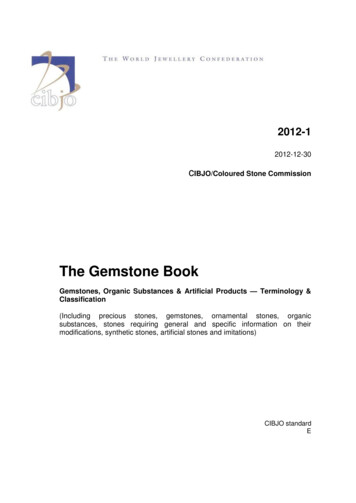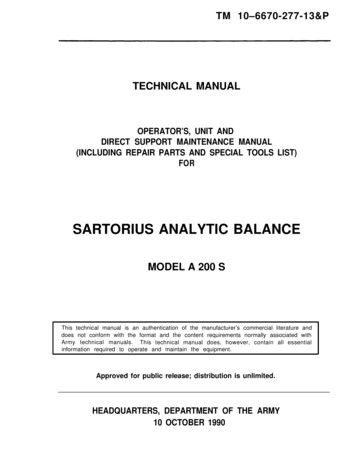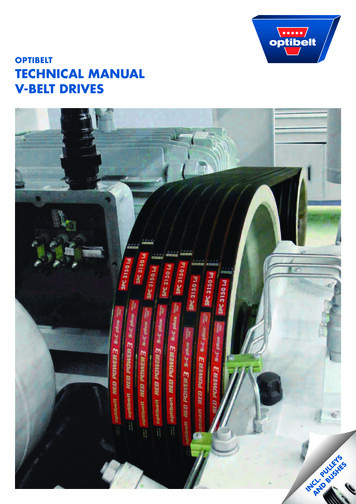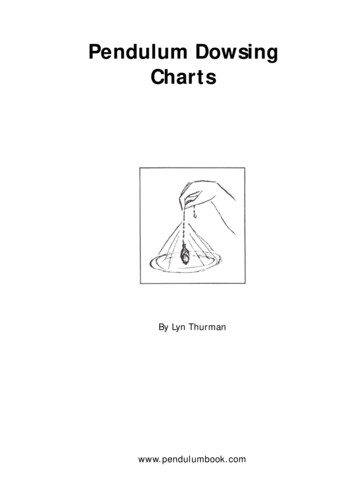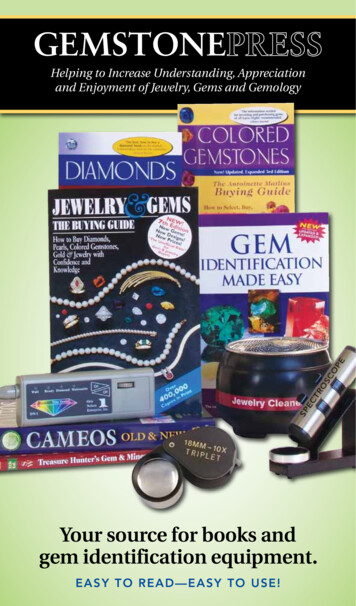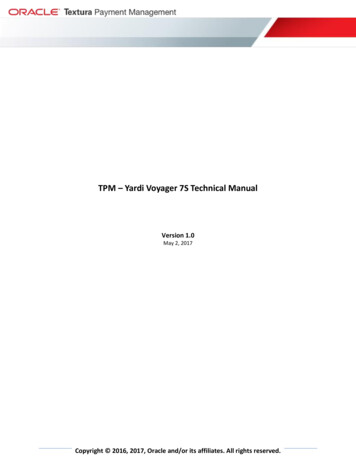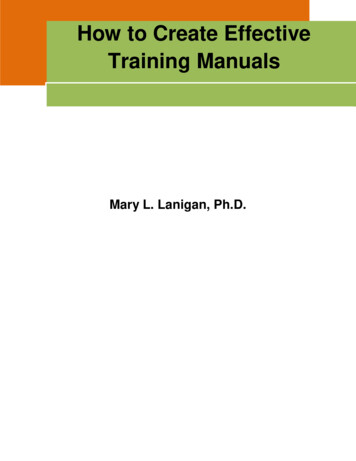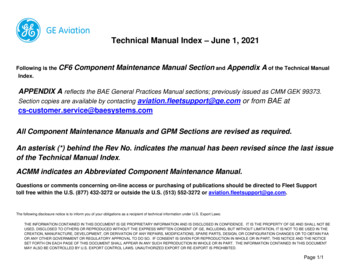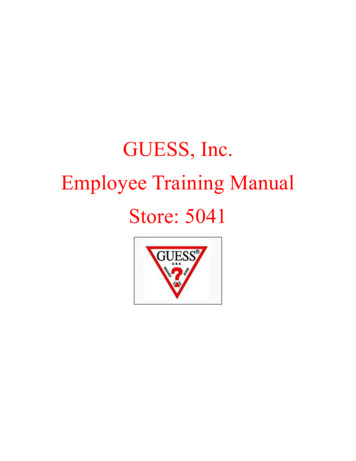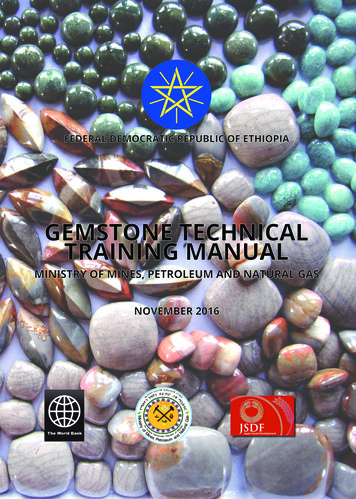
Transcription
FEDERAL DEMOCRATIC REPUBLIC OF ETHIOPIAGEMSTONE TECHNICALTRAINING MANUALMINISTRY OF MINES, PETROLEUM AND NATURAL GASNOVEMBER 2016
FOREWORDEstelle Levin Limited (ELL) and Sudca Development Consultants (Sudca) developed thistraining manual for the JSDF Project and the Government of Ethiopia’s Ministry of Mines,Petroleum, and Natural Gas (MOMPNG). It was financed by the World Bank administeredJSDF grant for support to improve the economic, social, and environmental sustainabilityof artisanal miners, with a particular emphasis on empowerment of women.The JSDF Project is coordinated by the Women and Youth Directorate of the MoMPNG.ELL Gemstone Expert Herizo Harimalala Tsiverisoa, authored the report, with contributions from: ELL Training Expert, Dr. Jennifer Hinton ELL Team Lead, Dr. John Tychsen;Sudca Gender Expert, Yimegnushal Takele; Sudca Environmental Expert, Andualem Taye;and ELL Project Manager, Adam Rolfe.The publication of this manual is the product of an extensive participatory research andpractical training process, which ran from April to November 2016. An initial needs assessment visit (April – May) focussed on the physical infrastructure of lapridary centres inKambolcha and on lapidary skills of women in Delanta and Wadlain in the Amhara region.This informed the design of draft training materials that were used to deliver a training tocooperatives / Women’s Economic Strengthening Groups and relevant governmentpersonnel (June). Feedback from the participants and the client was incorporated into thetraining material and subsequent design of the training manual.The manual prioritises: Adult learning techniques that maximise participation and learning-by-doing;and A Knowledge, Skills and Attitudes (K-S-A) approach to build capacity in technical content while empowering participants by increasing their Knowledgeand Skills to create gender-responsive trainers with the Attitudes necessaryto support future actions.The manual is intended for use by a variety of audiences to guide and supplement theirwork, whether directly or indirectly related to Artisanal and Small-scale Mining (ASM). Anon-exhaustive list of the potential users is as follows: The ASM Department of the MoMPNG MoMPNG Directorates working closely with the ASM, Environment & Community Development, Gender, Artisanal Mining Production and Marketing,Public Relations and Communications Directorates Regional Mining Bureaus Local Woreda and Kabele Officers (Gender, Mining, Environment) Artisanal and Small-scale Mining Cooperatives / Women’s Economic Strengthening Groups Artisanal and Small-scale Communities
CONTENTSSECTION 1: Guidelines for trainers1SECTION 2: Gender equity, rights & responsibilities in artisanal and small scalemining5SECTION 3: Introduction into gemstones14SECTION 4: Materials and equipment for lapidary and gem processing21SECTION 5: Introduction to lapidary techniques25SECTION 6: Focusing on opal31SECTION 7: Specificity of a lapidary workshop39APPENDICES42REFERENCES45I
SECTION 1: GUIDELINES FOR TRAINERSAny woman or man can become an excellent trainer! You don’t need to be an expert ona topic to help others learn new skills and ideas and improve their lapidary and valueaddition activities.Training is not just about giving information in a lecture. Training is about using differenttechniques and methods to positively change the behaviour and practices of the womenand men you are training. To do this, a good trainer will use different techniques andmethods to build upon trainees’ existing Knowledge, Skills, and Attitudes (“K-S-A”): K Knowledge. This is the facts or information that women and men know.For example, someone may know where salt is located but may not knowhow to mine it. S Skills. This is the ability to do something. For example, someone mayknow how to mine salt but may not know enough about how to improve itsquality and sell it at a better price. A Attitudes. How women and men act in or feel about a situation. This alsoincludes the values that people have. For example, someone may have skillsand knowledge about salt mining, but doesn’t have the initiative to learnhow to improve salt quality.This chapter describes: important characteristics of a good trainer; how a trainer canidentify and respond to the different K-S-A needs of trainees; and different methodstrainers can use to build K-S-A.1.1 WHAT MAKES A GOOD TRAINER?A good trainer will: Respect the existing knowledge, skills, and attitudes of people you are training and build-upon this by introducing something new (an idea, method, orway of working). Be encouraging, supportive, and patient. Understand that each personmight have different training needs. Some women and men miners willneed more time and encouragement than others. Help the women and men you are training by finding the solutions themselves.- ‐1Ask questions about what they know and how they think a problem canbe solved.
SECTION 1: GUIDELINES FOR TRAINERS- ‐Introduce new ideas and methods using your coaching and mentoringskills.- ‐Talk about what they learned and how it can improve people’s lives.- ‐Talk about possible unintended impacts of the new method and howyou can manage this. Remember that women and men may face different challenges speaking upor participating. A good trainer will adapt by taking steps to ensure all trainees benefit from training. Remember that different people have different KS-A and you may need to adapt your methods for women, men and othergroups (and may even need to train them separately). Keep a positive attitude! It takes time to change behaviours of trainees anda lot of practice to become a good trainer.1.2 IDENTIFYING THE TRAINING NEEDS OF MINERSTo identify the training needs of women and men miners, you will need to: Decide what women and men miners should know and be able to do, andthe attitude needed to increase their incomes, mine more safely, protecttheir health and the environment, and support the development of theirfamilies. Understand what women and men already know, can do and how they actor feel. Is this different for women’s and men’s groups? Will you need to adapt your training approach for each?Using each section of this manual, make and complete a table like the one below todecide what to focus on when you are training women and men miners:TopicKnowledgeWhatminersneed WOMENminersalreadyKNOWaboutWhatminersneed tobe ableto salreadyDOWhatkind ofattitudeminersneed dyknowLegal Rights:GemstoneIdentification:Materials andEquipment:Cut andpolish acabochon:2
SECTION 1: GUIDELINES FOR TRAINERSCut andpolish opal:Safety:Environment:Table 1: Men and Women KSA AnalysisFor each topic, decide what new knowledge, skills, and attitudes your trainees need. Usethis training guide to help you find the information you need to help train others.For each topic, decide what new knowledge, skills, and attitudes your trainees need. Usethis training guide to help you find the information you need to help train others. Reviewthe differences between the men and women you will train, as well as any intra-genderparticularities. How can you address these differences?To address training needs, particularly of women trainees, you should also consider thefollowing issues: Where will the training be done? Is it easy and inexpensive for trainees to ac-cess the location? How will it affect the trainees’ day-to-day lives? When will the training be done? How long or how often will you do it? Couldthis create a household conflict or inconvenience for trainees? How will youaddress this? What are the costs of the training for the trainee? Think about all costs (lostincome, transport, accommodation). Will they be able to afford to participate?How will you address this1.3 TRAINING METHODSUse a combination of methods depending on whether you want to build Knowledge (K),Skills (S), or Attitudes (A).KIND OF LEARNINGTRAINING METHODSKNOWLEDGE[Facts, Information] Lectures and presentationsReadingsSongs, Films, TV, and RadioBrainstorming, group, or one-on-one discussionsSKILLS[How to do something] DemonstrationsInstructions followed by hands-on practice.ATTITUDES[Values, what people think about things, how theyreact to things] Posters and visual aidsDiscussionRole plays and simulationsTable 2: Types of learning and methods for training3
SECTION 1: GUIDELINES FOR TRAINERSYou don’t need to organise a training workshop to be a ‘trainer’. Sometimes, the besttraining is done at the mine site. The most important field techniques you can use are ascoaches or mentors of women and men miners. Because women and men may have different training needs, it may be useful to coach or mentor them separately.To be an effective coach of artisanal miners:1. Focus on one method, skill, or way of working that you learned about during thetraining: Think about what you learned during this training. Pick one topicthat you think other miners would benefit from learning about. Rememberthat women and men miners might have different needs!2. Work with 1-3 miners at a time to teach them about the activity.- ‐Talk to the miners about why it would be useful to learn this new task orskill.- ‐Demonstrate and instruct the miners on the task or skill – do it together.- ‐Talk about what worked well, what did not and how they could improvenext time.3. Once the miners are comfortable using the new skill or methods, then introduce it to other miners OR focus on teaching miners about a differentmethod or topic.4. Re-visit the miners you trained later to make sure that they are using themethod in a proper way (or perhaps have improved on the method by adapting it).To be an effective mentor of artisanal miners:1. Give advice to women and men miners on a regular basis. Talk to individualminers about what they think they need to know to improve their miningactivities. Remember that women and men miners might have differentneeds!2. If you know about the topic then give the miners advice on the issue on aregular basis. Work with them to find solutions together.If you don’t know about the topic then ask for advice from those that do: for example mining officers at the Woreda Regional Mining Bureau (RMB) or Ministry of Mines. They mayneed to do some research to help you advise fellow miners.4
SECTION 2: GENDER EQUITY, RIGHTS & RESPONSIBILITIESSECTION 2: GENDER EQUITY, RIGHTS & RESPONSIBILITIESIN ARTISANAL AND SMALL SCALE MININGThe purpose of the present training manual is to improve the position of women minersin the mining production cycle and to enhance their benefits from mining activity.The focus of the following sections is the improvement of technical skills and theintroduction of modern, efficient, environmentally friendly and gender sensitivetechnologies. However, for this to contribute to impactful, meaningful, and sustainablechange for women, it is integral that trainees are trained in the importance of genderequity as well as their rights, roles, and responsibilities.By developing a better understanding of the present position of women in mining, aswell as legal provisions and government responsibilities to protect and promote the roleof women, this section will complement the skills learned in later sections and providetrainees with a basis for realising the benefits of the training programme when applyingtheir new skills.The introduction of new technologies and skills to operate them will only provide trainees with the potential to improve their livelihoods and the benefits of mining; an understanding of gender equity and their rights and responsibilities will permit the trainees toapply these skills in a way that maximises their potential.2.1 GENDER AND DEVELOPMENTIntroductionWomen constitute 26% of the mining households in Ethiopia (ASM Baseline Survey,Sudca, 2013). When we look at the gender distribution by mineral type, women hardlyparticipate in salt extraction and dimension stone production. They likewise have a verylimited role in gemstone mining. Thus, the only area where women engage as recognised miners is gold mining, which also varies from region to region. For example, inBenshangul-Gumuz Region, females [including girls] are very actively engaged and makeup 51%; while in Tigray, they represent 39% of the mining workforce. However, even inthese regions, where women constitute a considerable size of the mining workforce, thegender disparities between men and women as well as boys and girls are considerable.Does gender equity matter?Gender equity is not just a question of being fair to women and girls or narrowing theeconomic and social gaps between male and females. It is a matter of national andcommunity development. For instance, The Global Hunger Index indicates that countrieswith the highest levels of gender inequality show the highest levels of hunger. Thus, con-5
SECTION 2: GENDER EQUITY, RIGHTS & RESPONSIBILITIESfronting gender inequality stands out among the key elements of reducing hunger and,hence, of reducing poverty (USAID, 2011).Domains for analyzing gender inequalityASPIRATIONS:Children constitute a significant,although diminishing, proportion(5-10% depending on the region)of the ASM labour force in Ethiopia(EITI, 2016). Children, especiallygirls, are prone to high levels ofnon-enrolment, absenteeism, andschool dropout. This has a profound impact on the aspirations ofchildren of the present generationand the development of theircommunities, in much the sameway as it did for previous generations.Figure 1: Children in mining communities, particularly girls, are vulnerable toschool dropout, absenteeism or getting no education at all. (Photo – AmharaRegion, Wadla / Delanta area)GENDER DIVISION OF LABOR:Women report spending twothirds of their time in mining /mining related activies and therest on crop production, domesticchores and discharging their childcare responsibilities. Despite theseadditional burdens, women typically spend almost as much timeas men mining.All of the above factors result in adisproportionate work burden forwomen and girls, impacting theirdevelopment and aspirations. Inturn this can also determine theirsocial status. Often the problemsdetailed above are confounded infemale-headed households.Figure 2: Most women participate in food vending and picking tailings at themining sites (Photo - Amhara Region, Wadla / Delanta area )6
SECTION 2: GENDER EQUITY, RIGHTS & RESPONSIBILITIESACCESS TO AND CONTROL OVER ASSETS AND RESOURCES:Ownership of the majority of household assets such as family land holdings, houses,livestock, income, etc. in mining communities is primarily the reserve of men. In the caseof access to mining areas in gemstone producing areas, it is men that control access tosites and women largely play a support role through provision of services and / or collecting low value “ajara” (off-cuts) that are very low value.PARTICIPATION AND DECISION MAKING:Women have the most decision-making power over income they have generated. Wherethey are not involved in income generating activities, whether from social or culturalexclusion, there is a risk that gains (including those resulting from increased productivityleading to higher income in ASM households) could be misused. This could actuallyworsen the existing situation of women and girls if they are obligated to take on additional work burdens but restricted from accessing the improved income. This risk couldbe heightened if, for instance, machinery were to be co-opted by men. Conversely, assessment demonstrates that ASM women who actively participate tend to have astronger voice in community/collective issues, relative to their inputs at the household(HH) level.INSTITUTIONAL CAPACITY AND COLLABORATION AMONG PARTNERS:Some major factors slowing down the gender mainstreaming process in artisanal mining include: limited staff capacity in government to integrate gender; weak collaborationand interconnectedness across gender offices; and persistence of unorganised andhighly individualised mining operations.OTHER SOCIAL PROBLEMS:Many women around the mining areas are engaged in low paying and/or risky livelihoodactivities including food vending, catering, sale of goods, and sex work. The resultantmarginalisation can increase women and children’s exposure to child abuse, humantrafficking, HIV, gender-based violence, and/or harmful traditional practices. Lack ofknowledge about safety rules and on the need to use safety equipment, accompaniedwith exposure to toxic and poisonous chemicals is also an issue. The domestic divisionof labour means the workloads of women are reportedly increased by deforestation andits associated impacts on availability of water and firewood.GEMSTONE SPECIFIC GENDER CONSIDERATIONS:One aim of this training manual is to empower women to increase their participation inthe gemstone sector by improving their skills in value addition and processing of opal7
SECTION 2: GENDER EQUITY, RIGHTS & RESPONSIBILITIESand other gemstones. Skill development, paired with meaningful employment opportunities, will increase participation at high value stages of gemstone production. This willimprove incomes, reduce work burdens, and most importantly empower women at thehousehold and community level.The gender inequality issues discussed above are common across most mining types,regardless of the material. Below we present some additional gender issues particularto gemstone supply chains, resulting from the needs assessment conducted prior to theelaboration of the manual. Women rarely participate in the extraction stage of gemstone production.This is not because they are uninterested or are incapable of doing the job;rather in many cases they are systematically excluded from the extractionstage. The reasons for exclusion are often complex and a woman whowishes to engage in gemstone production typically will have to overcome anumber of obstacles including: cultural, practical, social, and technical. A dominant cultural norm can be an obstacle, for example: the opal business in Ethiopia has historically been dominated by men; that is simply ‘theway it’s always been done’. Practical obstacles can include valid securityconcerns. For example, working hours are often cited as a reason womendon’t participate in the extraction stage of gemstones. Where gemstone extraction is performed after sunset – in the dark, with no electricity – theconditions are perceived as too dangerous for women. This perception isvalidated by women consistently reporting that night-time working hours ofany kind increase their risk of sexual assault or attacks on their social status. Social obstacles that exclude women and girls from education cancreate low literacy or numeracy levels amongst women. This can precludeengagement in sectoral jobs that require bookkeeping, licenses, or paperwork. An example of a technical obstacle is when women lack the necessary skills to do a particular job in gemstone production. Technical training(like this one!) can help women identify or add value to the gemstones theyare selling or processing. Increased technical knowledge equips women toreceive appropriate payment for their time and labour. Typically several of these obstacles work together to restrict women fromfull participation in gemstone production and consequently restrict theirability to improve their incomes and standard of living. Nevertheless, a progressive approach is possible and useful: even targeting one or two of theseobstacles (such as cultural and technical obstacles) can vastly improve opportunities and participation. This is one aim of this manual. This and other ongoing training programmes are contributing to this progressive empowerment work. All stakeholders – including the MOMPNG,women miners and civil society - can and must continue to improve safeworking conditions for both women and men; reduce the specific risks8
SECTION 2: GENDER EQUITY, RIGHTS & RESPONSIBILITIESposed to women in and around the extraction sites, and address market related barriers to the participation of women in gemstone supply chains. A key indicator for monitoring the empowerment of women in the sector isto consider the decision making power of women. This means consideringto what extent women – whether in their personal lives, homes, communities, or workplaces – have or are increasing access to productive assets, information, and markets; have agency over these things; and are free andempowered to make meaningful decisions related to these things.2.2 LEGAL RIGHTS AND RESPONSIBILITIES OF WOMENAND MEN MINERSThe development of you, your family, and your community depends on whether therights of women, men, boys, and girls are respected, protected, and fulfilled! To dothis, women and men miners have to fulfil responsibilities while the government needs todischarge its obligations.What are the rights of women and men miners?According to the Constitution and the Mining Proclamations of Ethiopia:9 Eligibility for License: Noperson is required to possess financial resources,technical, and professionalcompetenceinorder to acquire an artisanalmininglicense.(Art.2, The Mining Proclamation, MOM 2010) All nationals can applythrough their RegionalMining Bureau for an artisanal license (Proclamation No. 816/2013). An artisanal license is valid for a period specified in the license (not exceeding two years) and is non-renewable (Proclamation No. 816/2013). The maximum area to be covered by a single license shall be 5,000m2 forartisanal mining operations. One can’t be a holder of two licenses at a time. (Art. 10, Council of Ministers,1994)Figure 3: Both women and men have the right to work in different areas ofthe mine (Source: Hinton et al, 2009)
SECTION 2: GENDER EQUITY, RIGHTS & RESPONSIBILITIES The right to be organised: ASM workers have the right to form associations or cooperatives to improve their conditions of work and economicwell-being. Women workers have the right to equal pay for equal work. (The Constitution Art. 42) Small-scale and special small-scale mining licenses are granted for an initial period of up to 10 years and can be renewed for 5 years (ProclamationNo. 816/2013). Please consult with your Regional Mining Bureau for furtherinformation. Environmental impact: Artisanal miners are not required to submit an environmental impact assessment or to allocate funds to cover the costs ofrehabilitation of environmental impact. (Art. 60, Council of Ministers, 1994)Legal rights concerning equal opportunities, equal pay for equalwork and non-discrimination Women shall, in the enjoyment of rights and protections provided for bythe Constitution, have equal rights with men. Women have equal rightswith men in marriage. (The Constitution Art. 35) Women have the right to acquire, administer, control, use, and transferproperty. In particular, they have equal rights with men with respect to use,transfer, administration and control of land. They shall also enjoy equaltreatment in the inheritance of property. (The Constitution Art. 35) Every Ethiopian has the right to engage freely in economic activity and topursue a livelihood of his choice anywhere within the national territory.(The Constitution Art. 41)Legal rights concerning safe working conditions To prevent harm arising from pregnancy and childbirth and in order tosafeguard their health, women have the right of access to family planningeducation, information, and capacity. (The Constitution Art. 35) Workers have the right to enjoy a healthy and safe working environment.Legal rights concerning access to justice Everyone has the right to bring a justiciable matter to, and to obtain a decision or judgment by, a court of law or any other competent body with judicial power. (The Constitution Art. 37)10
SECTION 2: GENDER EQUITY, RIGHTS & RESPONSIBILITIESThe responsibilities of women and men miners Royalty: The amount of royalty payable by the holders of artisanal andsmall-scale mining licenses shall be at the rate fixed by the laws of thestates. (Art. 63, Council of Ministers, 1994) Order of Processing of Applications: An application submitted for a largescale mining license shall take precedence over applications for small-scaleand artisanal mining licensees, and an application for small-scale mininglicense shall take precedence over an application for artisanal mininglicense; (Art. 13, Council of Ministers, 1994) Revoking a License: The Licensing Authority may, after giving 90 days priorwritten notice, revoke an artisanal mining license, but preferential treatment or compensation shall be given to the licensee. (Art. 32, Council ofMinisters, 1994) Termination of a License: Mining rights shall terminate if a license expireswithout being renewed or licensees acted unlawfully. (Art. 77, Council ofMinisters, 1994)Legal rights of children 11Every child has the right to life;to nationality; to know and becared for by his or her parentsor legal guardians; not to besubject to exploitative practices, neither to be requirednor permitted to performwork which may be hazardousor harmful to his or her education, health or well-being; tobe free of corporal punishment or cruel and inhumanetreatment in schools andother institutions responsiblefor the care of children. (TheConstitution Art. 36)Figure 4: Children’s RightsIn all actions concerning children undertaken, the primary consideration shall bethe best interest of the child. Children born out of wedlock shall have the samerights as children born in wedlock. The State shall accord special protection toorphans. (The Constitution Art. 36)
SECTION 2: GENDER EQUITY, RIGHTS & RESPONSIBILITIES Under special circumstances, children of age 14 and above can engage in safepaid works, but subject to limitations in working hours, not to work during weekends, and not to work overtime. Alternative education should be provided for young girls and boys engaged in themining activities; Parents/guardians are responsible for ensuring that both girls and boys enjoytheir right to rest, play, and attend school.2.3 OBLIGATIONS OF THE GOVERNMENTThe Government of Ethiopia has a legal obligation to respect, protect, and fulfil therights of its citizens. A few examples of important obligations of government include to: Fairly and without discrimination - on the basis of gender, class, or ethnicity- ensure that mandates (including those mandates of Regional Mining Bureau and Woreda offices related to technical assistance and advice to artisanal miners) are fulfilled; The State shall enforce the right of women to eliminate the influences ofharmful customs. Laws, customs, and practices that oppress or cause bodilyor mental harm to women are prohibited (The Constitution Art. 35); Provide training on legal right of women artisanal and small-scale miners toapply human rights and gender equality principles (avoid physical harassments and psychological torture); Create awareness to protect against the sexual exploitation of women andgirls by workers, traders and those who are engaged in other jobs aroundmining areas; Prevent harassment and discrimination; Strengthen the legal trading system in collaboration with responsible bodies such as police and trade bureaus to support women artisanal miners; Set-up mechanisms to protect the economic interests of girls who work forrelatives, friends of the family, or guardians; Make sure women, women’s organisations and associations are active participants in decision making, for example in consultations and meetings; Identify and address local and associational sources of conflict in artisanaland small-scale mining communities and promote conflict resolution, sincewomen are often the prime victims of conflicts that arise. In addition, itmust ensure active participation of women in resolving conflicts;12
SECTION 2: GENDER EQUITY, RIGHTS & RESPONSIBILITIES Develop regular and gender sensitive assessment and monitoring techniques to overcome the hurdles to positive change and to support the development of women in artisanal mining; Ensure that the rights of other land users are protected; and Provide Assistance - The government may provide incentives and assistance to artisanal mining carried out by cooperatives. (Art. 75, Council ofMinisters, 1994)2.4 WHAT TO DO WHEN RIGHTS ARE NOT RESPECTED, PROTECTED,AND FULFILLED?13 Appeal Procedures: Any person who is aggrieved by any administrativedecision of the Licensing Authority pursuant to Proclamation 816/2013 mayapply to the officials of the Licensing Authority hierarchically [Woreda - Regional - Federal] (Art. 79, Council of Ministers, 1994). After one has exhausted the administrative remedies with the LicensingAuthority, they may apply to the competent court for the review of an administrative decision contemplated in sub-article (1). In the case of any criminal act (such as sexual or physical violence or denialof payments), the victim may take their case to the local police or the relevant government administrative body for justice.
SECTION 3: INTRODUCTION TO GEMSTONESSECTION 3: INTRODUCTION TO GEMSTONES3.1 WHAT IS A GEMSTONE?A gemstone is the name given to a piece of mineral (or other rock or organic material)that after it has been cut and polished is made into a piece of jewellery or another accessory. Although gemstones are commonly made from minerals, material such as jet oramber or rocks like lapis lazuli can also be utilised in the creation of jewellery / accessories in a similar way to the above mentioned minerals. The majority of gemstones will behard to the touch but depending on the piece of jewellery that is being created, somesoft minerals are also utilised.3.2 HOW ARE GEMSTONES FORMED?Even though the vast majority of gemstones are created below the surface of the earth,there are a number of different ways that individual stones can be created. A
SECTION 3: Introduction into gemstones SECTION 4: Materials and equipment for lapidary and gem processing SECTION 5: Introduction to lapidary techniques SECTION 6: Focusing on opal SECTION 7: Spe
